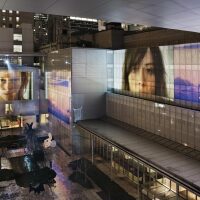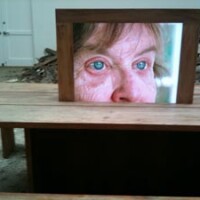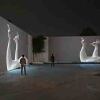Photos: Doug Aitken's Station to Station Stops By Los Angeles
It's the whistle-stop tour, re-imagined. Throughout September, California artist Doug Aitken has been travelling the country on a train packed with artists and musicians, traversing the country between the continental cultural bookends of California and New York. In cities ranging from Chicago to Winslow, Arizona, Aitken's Station to Station crew has been performing concerts, featuring the likes of Italo-disco innovator Giorgio Moroder, Jackson Browne and L.A. noiseniks No Age, and presenting art and video installations too.
On the train, the artists and musicians collaborated on works and created material that was inspired by their cross-country excursion. Musicians, after all, are experts at creating on the move, cramped bunks and close quarters are the most fertile ground for these wandering souls. This week the train rolled into Los Angeles, and set up shop at Union Station, where Beck, No Age, and community-oriented, electronic artist Dan Deacon performed last night. Yurts speckled the courtyard, providing experiences ranging from Urs Fischer's mirror-walled Lothario lounge to a felt-covered labyrinth only navigable by spelunking headlamps. Aitken was the alchemist behind it all, facilitating the introductions between the creatives whose interactions catalyze something new. His real artform is coordinating the conditions for creativity; he connects imaginations and stands back to witness the results.
The train was the muse for the public too, it was the prime mover in the generation of new online content, manifesting as blog posts, Instagram photos, and Facebook and Twitter updates, that reflected a fleeting experience would only exist in reality once, but will live forever in the digital reverberations. On the macro view, social media is the collective consciousness, of how we are and, often, the personae we want to be. At its best, social media is a collective diary that we write together.
In Los Angeles, we've recently witnessed two moments that created a similar digital ripple effect on the public as well: The moving of Michael Heizer's rock to the Los Angeles County Museum of Art and the relocating of the Endeavor space shuttle to the California Science Museum. Both moments acted as a reshifting of a city's focal point to a new nomadic center in decentralized mass of the Los Angeles megalopolis. These mass public events drew together people from many neighborhoods who were unified in a communal experience. Aitken's event was a bit different; it was magnetic North for arts and music enthusiasts, who then overlapped with the every day people of Union Station: weary eyed travelers, heartbroken lovers seeing saying goodbye for the last time, and excited families welcoming home distant relatives. Aitken created a social sculpture, an ephemeral happening that appeared and disappeared in an instant.
For a moment, Union Station became the heart of Los Angeles again, the pulmonary organ to which all arterial transit systems flowed. The art and music showcased was less about the individual pieces and instead created the Station itself into an art piece. In the way that art becomes art when you put a frame around something special, Aitken's event was the frame to reconsider Union Station. In the negative space between Beck's songs, Union Station became the star, a figure-ground shift that realigned from the man, and choir on stage, to the building itself: those flying saucer light fixtures hovering overhead, the ornate woodwork, and the elaborate tile-work whose through-line traces back to Mexican haciendas then to Spanish estates and finally to North African mosques. As the headliner, Beck was an apt representation of one possible trajectory of Los Angeles youth. While Beck performed a harmonica-howling rendition of his one of his oldest songs, from the album "One Foot in the Grave," for a moment, we witnessed the same man who once crashed on couches and performed acoustic shows in living rooms as a North East Los Angeles teenager. He told of his own memories of Union Station, about waiting for trains as a listless youth.
Travel, of course, becomes a greater metaphor for life, and our own journeys: sometimes you catch the train, and sometimes you miss it, but the station always lives on.
Dig this story? Sign up for our newsletter to get unique arts & culture stories and videos from across Southern California in your inbox. Also, follow Artbound on Facebook and Twitter.









